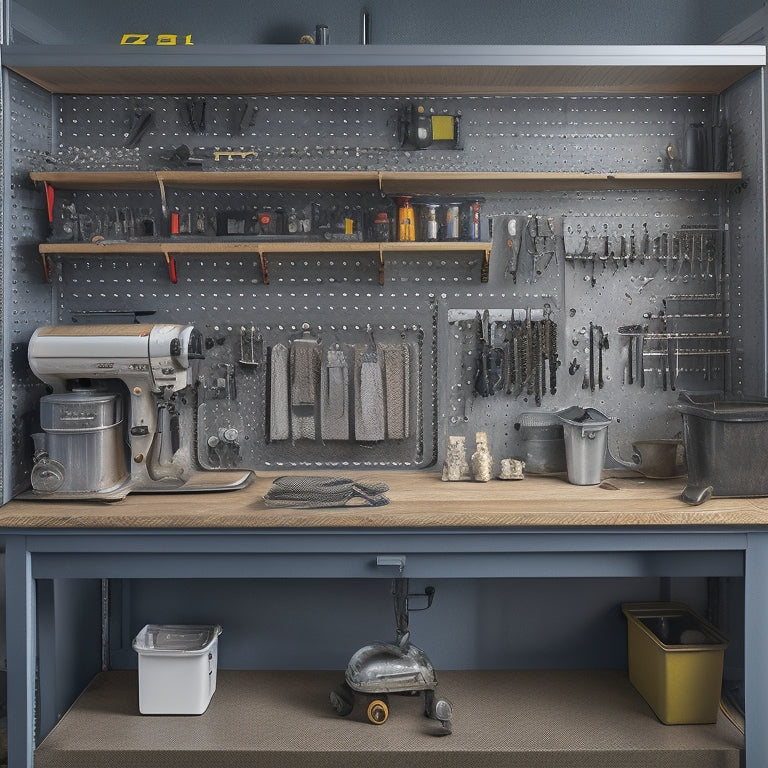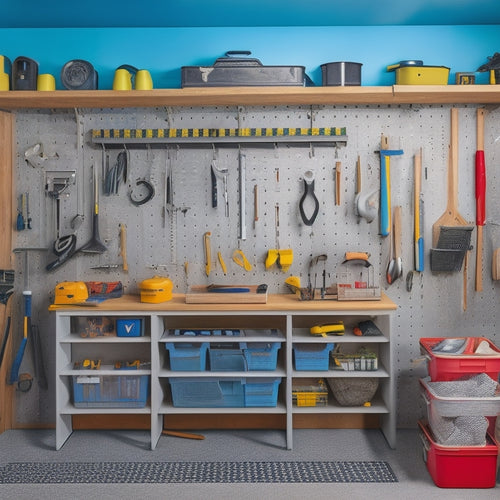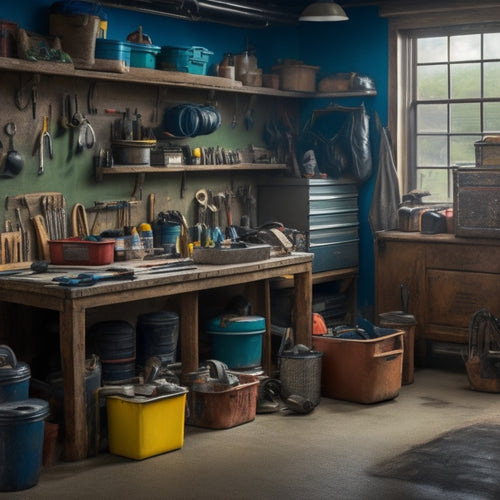
5 Essential Hacks for Clutter-Free Tool Storage
Share
You're ready to tame the tool storage chaos! Start by purging unnecessary tools, sorting them into keep, donate/sell, and discard piles. Next, optimize your toolbox real estate with customizable inserts and adjustable compartments. Label and categorize your tools, using a color-coding system for visual organization. Utilize vertical storage space with ceiling hooks, wall panels, and pegboards to keep tools organized and accessible. Finally, designate a home for each tool, so you can quickly find what you need. By following these essential hacks, you'll be well on your way to a clutter-free tool storage system - and uncover even more ways to maximize your space.
Key Takeaways
• Purge unnecessary tools to declutter and identify essential tools that need storage.
• Optimize toolbox real estate with customizable inserts and compartments for efficient storage.
• Label and categorize tools into groups like hand tools and power tools for easy identification.
• Utilize vertical storage space with ceiling hooks, wall panels, and pegboards to maximize storage without sacrificing floor space.
• Designate a home for each tool and develop a storage routine to prevent clutter and save time.
Purge Unnecessary Tools First
Before you can effectively store your tools, you need to rid your collection of anything that's broken, outdated, or simply no longer useful to you. It's tough, I know - it's easy to fall victim to tool hoarding. You might feel an emotional attachment to that rusty old wrench or the drill you've had since college. But let's be real, if you haven't used it in a year, you probably won't miss it.
Take everything out of your toolbox and sort items into three piles: keep, donate/sell, and discard. Be honest with yourself - if something's broken beyond repair, it's time to let it go. Consider donating gently used tools to a local charity or selling them online. You'll be surprised at how freeing it feels to declutter your collection. Plus, you'll have a better idea of what you actually need to store.
Optimize Toolbox Real Estate
Now that you've pared down your tool collection to only the essentials, it's time to think strategically about how you'll use the space inside your toolbox to maximize storage efficiency. You want to make the most of every inch, ensuring each tool has a designated home and is easily accessible.
To achieve this, consider incorporating customizable inserts and adjustable compartments into your toolbox. These features allow you to tailor your storage space to your specific needs, ensuring a snug fit for each tool.
Here are some ideas to get you started:
| Tool Category | Storage Solution |
|---|---|
| Hand tools | Small, individual compartments for each tool |
| Power tools | Adjustable dividers for cordless drills and saws |
| Fasteners | Customizable inserts for screws, nuts, and bolts |
| Measuring tools | Long, narrow compartments for tapes and levels |
Label and Categorize Tools
Organize your tools into categories, such as hand tools, power tools, and fasteners, and assign a specific label to each group, making it easy to identify where everything goes. This will help you quickly find the tool you need and prevent clutter from building up again.
Take it a step further by implementing a color-coding system, where each category has its own distinct color. For example, you could use blue labels for hand tools and red labels for power tools. This visual cue will make it even easier to navigate your tool collection.
To take your tool organization to the next level, consider tool personalization. Assign a specific tool to a specific task or project, and label it accordingly. This will help you remember which tool is best suited for a particular job, and ensure that you always have the right tool for the task at hand.
Utilize Vertical Storage Space
How can you maximize your tool storage space without sacrificing valuable floor or bench real estate? The answer lies in utilizing vertical storage space. By taking advantage of your ceiling and walls, you can free up precious floor space and keep your tools organized and within reach.
Install ceiling hooks to hang items like bikes, ladders, or even infrequently used tools. This won't only save floor space but also keep these items out of the way, reducing clutter and tripping hazards.
For more frequently used tools, consider installing wall panels with hooks, bins, or a pegboard. This will keep your tools organized, easy to access, and visible, making it simpler to find what you need when you need it. Additionally, wall-mounted storage solutions can be customized to fit your specific needs, ensuring that every tool has a designated spot.
Designate a Home for Each Tool
By assigning a specific spot for each tool, you'll guarantee that everything has a designated home, making it easier to find what you need and preventing clutter from building up in the future. This approach helps you develop a storage routine that becomes second nature, saving you time and reducing frustration.
When designating a home for each tool, consider your tool personality. Are you a neat freak or a bit more laid-back? Do you prefer tools organized by category or frequency of use? Answering these questions will help you create a system that works for you.
Here are some tips to keep in mind:
-
Label everything: Labels help you quickly identify where each tool belongs, making it easier to maintain your system.
-
Store tools by frequency of use: Keep your most frequently used tools in easy-to-reach locations, and store less frequently used tools on higher or lower shelves.
-
Keep similar tools together: Grouping similar tools, like all your screwdrivers or wrenches, makes them easier to find and prevents clutter from building up.
Frequently Asked Questions
How Often Should I Clean and Maintain My Tool Storage System?
Just like the ancient Greeks purged their temples of impurities, you should perform a Seasonal Purge of your tool storage to keep it clutter-free. Also, make Daily Inspections a habit to maintain order and guarantee everything has its designated spot.
Can I Use Old Furniture for DIY Tool Storage Solutions?
You can breathe new life into old furniture by upcycling shelves or repurposing cabinets into DIY tool storage solutions, giving you a unique and functional space that's both eco-friendly and budget-friendly.
Are There Any Smart Ways to Store Small, Loose Parts?
You'll love using part organizers with small compartments to store tiny parts, and magnetic strips on your workbench or wall to keep metal bits within easy reach, keeping your workspace tidy and efficient.
How Do I Protect My Tools From Rust and Corrosion?
"Oh, you want to protect your precious tools from rust and corrosion? Ha! Good luck with that. But seriously, you'll need rust prevention methods like silicone-based sprays and corrosion control strategies like storing them in dry, ventilated areas."
Can I Store Tools in a Humid or Outdoor Environment?
You can store tools in a humid or outdoor environment, but you'll need to take extra precautions. Use waterproof containers and consider climate control measures to maintain a stable temperature and humidity level.
Related Posts
-

Heavy-Duty Pegboard Hooks for Industrial Use
You need heavy-duty pegboard hooks that can withstand the rigors of industrial use, providing a reliable and efficien...
-

Advantages of a Pegboard System in Your Garage
You can instantly alter your garage into a more organized, efficient, and productive space by installing a pegboard s...
-

Best Cheap Tool Boxes for Budget-Conscious Buyers
You need a reliable tool box that gets the job done without breaking the bank. Look for durable materials, rust-resis...


